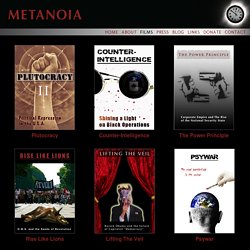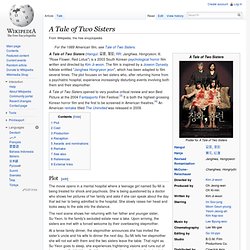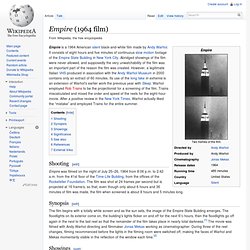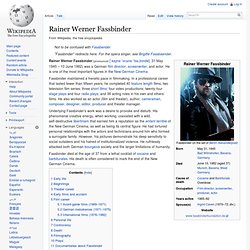

Deleuze Cinema Project 1. Vol 15, No 1 (2011) Films. Plutocracy Counter-Intelligence.

Remodernist film. Remodernist film developed in the United States and the United Kingdom in the early 21st century with ideas related to those of the international art movement Stuckism and its manifesto, Remodernism. Key figures are Jesse Richards and Peter Rinaldi. Manifesto and philosophy[edit] On August 27, 2008, Jesse Richards published a 15 point Remodernist Film Manifesto, calling for a "new spirituality in cinema", use of intuition in filmmaking, as well as describing the remodernist film as being a "stripped down, minimal, lyrical, punk kind of filmmaking". Point 4 is: The Japanese ideas of wabi-sabi (the beauty of imperfection) and mono no aware (the awareness of the transience of things and the bittersweet feelings that accompany their passing), have the ability to show the truth of existence, and should always be considered when making the remodernist film. Fellini: I'm a Born Liar. Fellini: I'm a Born Liar (French: Fellini, je suis un grand menteur) is a 2002 French documentary film written and directed by Damian Pettigrew.

Based on Federico Fellini's last confessions[2] filmed by Pettigrew in Rome in 1991 and 1992 (Fellini died in 1993), the film eschews straightforward biography to highlight the Italian director's unorthodox working methods, conscience, and philosophy. The film was nominated for Best Documentary at the European Film Awards, Europe's equivalent of the Oscars.
Certified Copy: How can you be in two spaces at once...? - scanners. "It's enigmatic and obvious, exasperating and beguiling, heavy-handed and understated, witty and poignant, all at once.

" -- Alex Ramon, Boycotting Trends What I like most about Abbas Kiarostami's "Certified Copy" is its slipperiness. The Tuscan textures are ravishing (it takes place over the course of an afternoon in and around the village of Lucignano -- or does it?) , Juliette Binoche and William Shimell are easy on they eyes and ears (good thing, too, since the movie is practically one long conversation -- or is it?) Antonioni’s Environments. Unknown White Male - (Documentary 2005) Dirt! The Movie. A look at man’s relationship with Dirt.

Dirt and humans couldn’t be closer. We started our journey together as stardust, swirled by cosmic forces into our galaxy, solar system, and planet. We are made of the same stuff. Four billion years of evolution created dirt as the living source of all life on Earth including humans. The Movie. How to read a movie. Above: Hitchcock's "Notorious" (1946).

Bergman on strong axis. Grant at left. Bergman lighter, Grant shadowed. Grant above, Bergman below. Movement toward lower right. I've mentioned from time to time the "shot at a time" sessions I do at film festivals and universities, sifting through a film with the help of the audience. This all began for me in about 1969, when I started teaching a film class in the University of Chicago's Fine Arts program.
I did. One thing I quickly discovered was that even much smaller audiences can contain someone who can answer any question. Of course you don't simply creep along and talk about what you're looking at. I bought some books that were enormously helpful. A Tale of Two Sisters. A Tale of Two Sisters (Hangul: 장화, 홍련; RR: Janghwa, Hongryeon; lit.

"Rose Flower, Red Lotus") is a 2003 South Korean psychological horror film written and directed by Kim Ji-woon. The film is inspired by a Joseon Dynasty folktale entitled "Janghwa Hongryeon jeon", which has been adapted to film several times. The plot focuses on two sisters who, after returning home from a psychiatric hospital, experience increasingly disturbing events involving both them and their stepmother. Plot[edit] The movie opens in a mental hospital where a teenage girl named Su-Mi is being treated for shock and psychosis.
The next scene shows her returning with her father and younger sister, Su-Yeon, to the family's secluded estate near a lake. Paris Is Burning (film) Paris Is Burning is a 1990 American documentary film directed by Jennie Livingston.

Filmed in the mid-to-late 1980s, it chronicles the ball culture of New York City and the African-American, Latino, gay, and transgender communities involved in it. Many members of the ball culture community consider Paris Is Burning to be an invaluable documentary of the end of the "Golden Age" of New York City drag balls, as well as a thoughtful exploration of race, class, gender, and sexuality in America.[2] The film explores the elaborately-structured ball competitions in which contestants, adhering to a very specific category or theme, must "walk" (much like a fashion model's runway) and subsequently be judged on criteria including the "realness" of their drag, the beauty of their clothing and their dancing ability.
Most of the film alternates between footage of balls and interviews with prominent members of the scene, including Pepper LaBeija, Dorian Corey, Angie Xtravaganza, and Willi Ninja. Humphrey Jennings. Frank Humphrey Sinkler Jennings (19 August 1907 – 24 September 1950) was an English documentary filmmaker and one of the founders of the Mass Observation organisation.

Jennings was described by film critic and director Lindsay Anderson in 1954 as: "the only real poet that British cinema has yet produced. "[1] Early life and career[edit] Born in Walberswick, Suffolk, Jennings was the son of Guild Socialists, an architect father and a painter mother. Green Films: The Best Environmental Documentaries.
Kenneth Anger. Empire (1964 film) Empire was filmed on the night of July 25–26, 1964 from 8:06 p.m. to 2:42 a.m. from the 41st floor of the Time-Life Building, from the offices of the Rockefeller Foundation.

The film was shot at 24 frames per second but is projected at 16 frame/s, so that, even though only about 6 hours and 36 minutes of film was made, the film when screened is about 8 hours and 5 minutes long. The film begins with a totally white screen and as the sun sets, the image of the Empire State Building emerges. Rainer Werner Fassbinder. Rainer Werner Fassbinder (pronounced [ˈʀaɪ̯nɐ ˈvɛʁnɐ ˈfasˌbɪndɐ]; 31 May 1945 – 10 June 1982) was a German film director, screenwriter, and actor.

He is one of the most important figures in the New German Cinema. Underlying Fassbinder's work was a desire to provoke and disturb. His phenomenal creative energy, when working, coexisted with a wild, self-destructive libertinism that earned him a reputation as the enfant terrible of the New German Cinema, as well as being its central figure. He had tortured personal relationships with the actors and technicians around him who formed a surrogate family. However, his pictures demonstrate his deep sensitivity to social outsiders and his hatred of institutionalized violence. Berlin Alexanderplatz (television) It was a co-production between the German Westdeutscher Rundfunk (WDR), Bavaria Film GmbH and the Italian network RAI. Production of the film at the Bavaria Film Studios took nearly a year. Director Fassbinder dreamed of making a 'parallel' film specifically for theatrical distribution after the completion of this series. The cast list he made for this fantasy included Gérard Depardieu as Franz Biberkopf and Isabelle Adjani as Mieze. 1: The Punishment Begins Berlin, 1928.
Franz Biberkopf is released after serving four years in Tegel prison for killing his girlfriend Ida. 2: How is One to Live if One Doesn’t Want to Die? 3: A Hammer Blow to the Head Can Injure the Soul Lina is now troubled by the dubious nature of the job Franz is fulfilling. 5: A Reaper with the Power of Our Lord Franz finally becomes re-acquainted with Eva, after several fleeting encounters. 6: Love Has Its Price Franz explains to Reinhold that he wants Cilly to remain with him. 10. 11. 12. 13. 14.
Robert Bresson. Robert Bresson (French: [ʁɔbɛʁ bʁɛsɔ̃]; 25 September 1901 – 18 December 1999)[1] was a French film director known for his spiritual and ascetic style. He contributed notably to the art of film and influenced the French New Wave. He is often referred to as the most highly regarded French filmmaker after Jean Renoir.[2] Bresson's influence on French cinema was once described by Jean-Luc Godard, who wrote "Robert Bresson is French cinema, as Dostoevsky is the Russian novel and Mozart is German music.
"[3] ANDREI TARKOVSKY'S CINEMA OF SPIRITUALITY. Michelangelo Antonioni. About Us. Senses of Cinema is an online journal devoted to the serious and eclectic discussion of cinema. We believe cinema is an art that can take many forms, from the industrially-produced blockbuster to the hand-crafted experimental work; we also aim to encourage awareness of the histories of such diverse forms. Guardian.co.uk Film. Lukas Moodysson. Early life[edit] Born in Lund, Moodysson grew up in Åkarp, Skåne County as an outcast, expressing himself through poetry. By the time he was 23 he had written five poetry collections and a novel published by Wahlström & Widstrand.[2] He decided to move to film to produce works that were less introverted and could be enjoyed by a wider audience than poetry.
After studying at what was then Sweden's only film school, the Dramatiska Institutet, he directed three short films before moving to features. Filmmaking[edit] Celine and Julie Go Boating. Sátántangó. Inferno (1980 film) Inferno is a 1980 Italian supernatural horror film, written and directed by Dario Argento. Acidemic - Film.